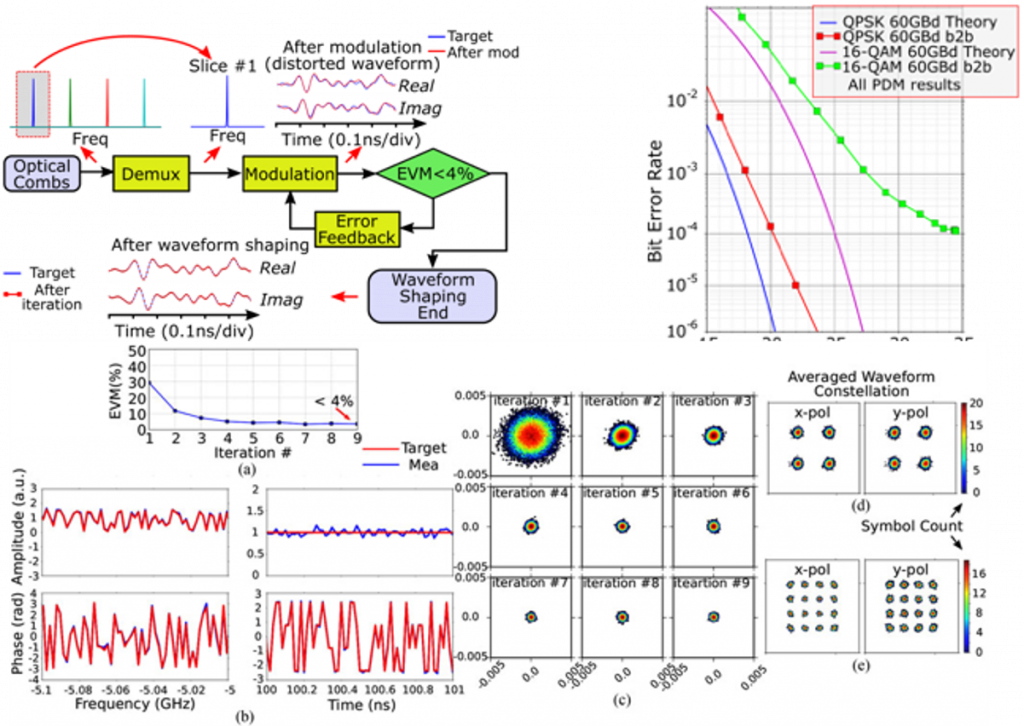Technology Overview
As described in the OAWG and OAWM technology section and in the SVBT technology section, the symbiotic relationship between the RF and photonic coherent signal processing implies profound opportunities for achieving scalable and high-fidelity signal processing. In OAWG, the signal processing utilize divide-and-conquer steps to achieve high fidelity across THz bandwidths [1]. When measurement-based feedback is available (for instance with OAWM), iterations lead to achieving improved error-vector-magnitude below 4% for even advanced modulation format at high spectral efficiency. Figure 2 demonstrates Iterative RF-photonic signal processing to achieve EVM below 4% at PSK and 16-QAM modulation format [2].
It is also possible to include RF-photonic lattice filters in conjunction with OAWG/OAWM devices to reduce the burden on the electronic DSPs by inclusion of the analog RF-photonic signal processing offered by the lattice filter. As Figure 3 illustrates, the silicon photonic lattice filters can support both FIR and IIR functionalities from the design shown by changing the coupling coefficient between the ring resonator and the rest of the unit cell from 1.0 to other values. Figure 4 shows the measured RF-photonic filter response from the fabricated unit cell when each of the five pn junction current value changes. As Figure 5 illustrates, more complex multi-stage silicon photonic lattice filters can be synthesized much like the digital filter synthesis utilizing the modified Schur algorithm.





Current Research Activities
A short summary of current research activities are as follows.
- Design of a new signal processing method exploiting new photonic devices such as AWGs, lattice filters, and 3D photonics, etc.
- High-fidelity and high-capacity signal processing with extremely low power consumption utilizing photonic components.
- Realization of temporal, spectral, and/or spatial pattern recognition utilizing photonic components.
- Machine learning engines utilizing photonic components.
References
- Yoo, S.J.B., et al., Terahertz Information and Signal Processing by RF-Photonics. IEEE Transactions on Terahertz Science and Technology, 2012. 2(2): p. 167-176.
- Guan, B., et al., Optical Spectrally Sliced Transmitter for High Fidelity and Bandwidth Scalable Waveform Generation. Journal of Lightwave Technology, 2016. 34(2): p. 737-744.
- Djordjevic, S.S., et al., Fully Reconfigurable Silicon Photonic Lattice Filters With Four Cascaded Unit Cells. IEEE Photonics Technology Letters, 2011. 23(1): p. 42-44.
- Ibrahim, S., et al., Demonstration of a fast-reconfigurable silicon CMOS optical lattice filter. Optics Express, 2011. 19(14): p. 13245-13256.
- Guan, B., et al., CMOS Compatible Reconfigurable Silicon Photonic Lattice Filters using Cascaded Unit Cells for RF-Photonic Processing. Selected Topics in Quantum Electronics, IEEE Journal of, 2014. PP(99): p. 1-1.
